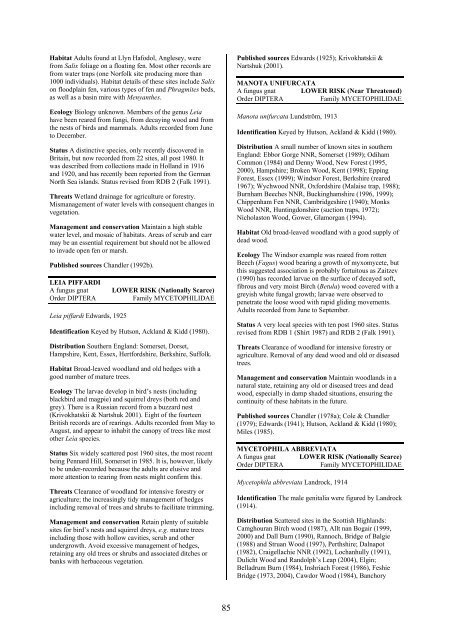Part 2: Nematocera and Aschiza not dealt with by Falk (1991) - JNCC
Part 2: Nematocera and Aschiza not dealt with by Falk (1991) - JNCC
Part 2: Nematocera and Aschiza not dealt with by Falk (1991) - JNCC
Create successful ePaper yourself
Turn your PDF publications into a flip-book with our unique Google optimized e-Paper software.
Habitat Adults found at Llyn Hafodol, Anglesey, were<br />
from Salix foliage on a floating fen. Most other records are<br />
from water traps (one Norfolk site producing more than<br />
1000 individuals). Habitat details of these sites include Salix<br />
on floodplain fen, various types of fen <strong>and</strong> Phragmites beds,<br />
as well as a basin mire <strong>with</strong> Menyanthes.<br />
Ecology Biology unknown. Members of the genus Leia<br />
have been reared from fungi, from decaying wood <strong>and</strong> from<br />
the nests of birds <strong>and</strong> mammals. Adults recorded from June<br />
to December.<br />
Status A distinctive species, only recently discovered in<br />
Britain, but now recorded from 22 sites, all post 1980. It<br />
was described from collections made in Holl<strong>and</strong> in 1916<br />
<strong>and</strong> 1920, <strong>and</strong> has recently been reported from the German<br />
North Sea isl<strong>and</strong>s. Status revised from RDB 2 (<strong>Falk</strong> <strong>1991</strong>).<br />
Threats Wetl<strong>and</strong> drainage for agriculture or forestry.<br />
Mismanagement of water levels <strong>with</strong> consequent changes in<br />
vegetation.<br />
Management <strong>and</strong> conservation Maintain a high stable<br />
water level, <strong>and</strong> mosaic of habitats. Areas of scrub <strong>and</strong> carr<br />
may be an essential requirement but should <strong>not</strong> be allowed<br />
to invade open fen or marsh.<br />
Published sources Ch<strong>and</strong>ler (1992b).<br />
LEIA PIFFARDI<br />
A fungus gnat<br />
Order DIPTERA<br />
Leia piffardi Edwards, 1925<br />
LOWER RISK (Nationally Scarce)<br />
Family MYCETOPHILIDAE<br />
Identification Keyed <strong>by</strong> Hutson, Ackl<strong>and</strong> & Kidd (1980).<br />
Distribution Southern Engl<strong>and</strong>: Somerset, Dorset,<br />
Hampshire, Kent, Essex, Hertfordshire, Berkshire, Suffolk.<br />
Habitat Broad-leaved woodl<strong>and</strong> <strong>and</strong> old hedges <strong>with</strong> a<br />
good number of mature trees.<br />
Ecology The larvae develop in bird’s nests (including<br />
blackbird <strong>and</strong> magpie) <strong>and</strong> squirrel dreys (both red <strong>and</strong><br />
grey). There is a Russian record from a buzzard nest<br />
(Krivokhatskii & Nartshuk 2001). Eight of the fourteen<br />
British records are of rearings. Adults recorded from May to<br />
August, <strong>and</strong> appear to inhabit the canopy of trees like most<br />
other Leia species.<br />
Status Six widely scattered post 1960 sites, the most recent<br />
being Pennard Hill, Somerset in 1985. It is, however, likely<br />
to be under-recorded because the adults are elusive <strong>and</strong><br />
more attention to rearing from nests might confirm this.<br />
Threats Clearance of woodl<strong>and</strong> for intensive forestry or<br />
agriculture; the increasingly tidy management of hedges<br />
including removal of trees <strong>and</strong> shrubs to facilitate trimming.<br />
Management <strong>and</strong> conservation Retain plenty of suitable<br />
sites for bird’s nests <strong>and</strong> squirrel dreys, e.g. mature trees<br />
including those <strong>with</strong> hollow cavities, scrub <strong>and</strong> other<br />
undergrowth. Avoid excessive management of hedges,<br />
retaining any old trees or shrubs <strong>and</strong> associated ditches or<br />
banks <strong>with</strong> herbaceous vegetation.<br />
Published sources Edwards (1925); Krivokhatskii &<br />
Nartshuk (2001).<br />
MANOTA UNIFURCATA<br />
A fungus gnat LOWER RISK (Near Threatened)<br />
Order DIPTERA<br />
Family MYCETOPHILIDAE<br />
Ma<strong>not</strong>a unifurcata Lundström, 1913<br />
Identification Keyed <strong>by</strong> Hutson, Ackl<strong>and</strong> & Kidd (1980).<br />
Distribution A small number of known sites in southern<br />
Engl<strong>and</strong>: Ebbor Gorge NNR, Somerset (1989); Odiham<br />
Common (1984) <strong>and</strong> Denny Wood, New Forest (1995,<br />
2000), Hampshire; Broken Wood, Kent (1998); Epping<br />
Forest, Essex (1999); Windsor Forest, Berkshire (reared<br />
1967); Wychwood NNR, Oxfordshire (Malaise trap, 1988);<br />
Burnham Beeches NNR, Buckinghamshire (1996, 1999);<br />
Chippenham Fen NNR, Cambridgeshire (1940); Monks<br />
Wood NNR, Huntingdonshire (suction traps, 1972);<br />
Nicholaston Wood, Gower, Glamorgan (1994).<br />
Habitat Old broad-leaved woodl<strong>and</strong> <strong>with</strong> a good supply of<br />
dead wood.<br />
Ecology The Windsor example was reared from rotten<br />
Beech (Fagus) wood bearing a growth of myxomycete, but<br />
this suggested association is probably fortuitous as Zaitzev<br />
(1990) has recorded larvae on the surface of decayed soft,<br />
fibrous <strong>and</strong> very moist Birch (Betula) wood covered <strong>with</strong> a<br />
greyish white fungal growth; larvae were observed to<br />
penetrate the loose wood <strong>with</strong> rapid gliding movements.<br />
Adults recorded from June to September.<br />
Status A very local species <strong>with</strong> ten post 1960 sites. Status<br />
revised from RDB 1 (Shirt 1987) <strong>and</strong> RDB 2 (<strong>Falk</strong> <strong>1991</strong>).<br />
Threats Clearance of woodl<strong>and</strong> for intensive forestry or<br />
agriculture. Removal of any dead wood <strong>and</strong> old or diseased<br />
trees.<br />
Management <strong>and</strong> conservation Maintain woodl<strong>and</strong>s in a<br />
natural state, retaining any old or diseased trees <strong>and</strong> dead<br />
wood, especially in damp shaded situations, ensuring the<br />
continuity of these habitats in the future.<br />
Published sources Ch<strong>and</strong>ler (1978a); Cole & Ch<strong>and</strong>ler<br />
(1979); Edwards (1941); Hutson, Ackl<strong>and</strong> & Kidd (1980);<br />
Miles (1985).<br />
MYCETOPHILA ABBREVIATA<br />
A fungus gnat LOWER RISK (Nationally Scarce)<br />
Order DIPTERA<br />
Family MYCETOPHILIDAE<br />
Mycetophila abbreviata L<strong>and</strong>rock, 1914<br />
Identification The male genitalia were figured <strong>by</strong> L<strong>and</strong>rock<br />
(1914).<br />
Distribution Scattered sites in the Scottish Highl<strong>and</strong>s:<br />
Camghouran Birch wood (1987), Allt nan Bogair (1999,<br />
2000) <strong>and</strong> Dall Burn (1990), Rannoch, Bridge of Balgie<br />
(1988) <strong>and</strong> Struan Wood (1997), Perthshire; Dalnapot<br />
(1982), Craigellachie NNR (1992), Lochanhully (<strong>1991</strong>),<br />
Dulicht Wood <strong>and</strong> R<strong>and</strong>olph’s Leap (2004), Elgin;<br />
Belladrum Burn (1984), Inshriach Forest (1986), Feshie<br />
Bridge (1973, 2004), Cawdor Wood (1984), Banchory<br />
85
















